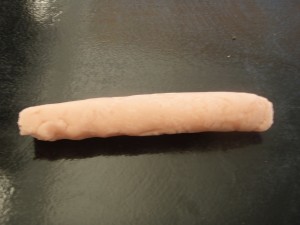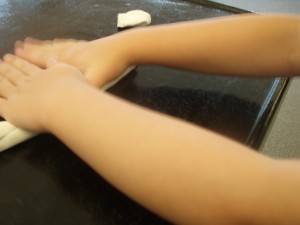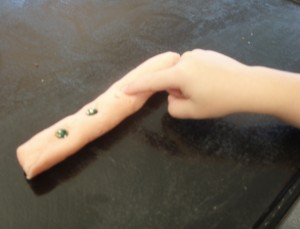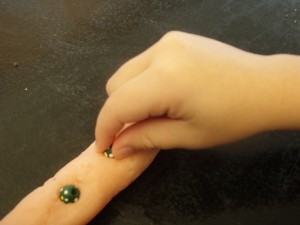Play dough is a favorite of many children. This time tested activity strengthen the hands and is a great entrée into touch exploration.
Benefits:
- Hand strengthening occurs when the fingers are fully extended (straight) and used to press down and roll the dough back and forth to make coils. Children, typically call these “snakes” or “hot dogs.”
- Isolating or pointing the index or “pointer” finger is also a critical component to fine motor dexterity.
- Pinching the play dough to make bowls helps strengthen thumb to finger tip opposition.
- Play dough has texture and provides tactile (touch) stimulation.
Directions:
1. The child rolls out a coil. Encourage straight fingers.
2. Then point the index finger and poke holes into the dough.
3. By starting on the left and working towards the right, the left-right directional concept necessary for reading and writing begins to form.
4. Older preschoolers and Kindergarten children place small stones (such as used in the game Mancala), marbles or simply stones collected outside and rinsed off, on top of the coil in a left to right fashion as described above. Once placed, the objects are pushed into the dough with the extended index finger while counting.
4. To add a more specific academic demand, have number cards for the child to determine how many stones to put in each time.
5. After the stones are placed, the child pulls the stones back out using a pincer grasp (pinched between the thumb and index finger tip. Pulling the stones out should have some resistance, thereby strengthening this all important grasping pattern.
6. Older students can follow the same pattern but work with more complex concepts or creating patterns. Along with strengthening, pattern sequencing and spatial skills can be nurtured. For example: A-BB-C-A-BB-C pattern with colored stones.
7. Consider using flash cards to add and subtract stones.
8. Second grade and on can use chips (like bingo or poker) instead of stones. This requires more strength in the pincer grasp for placing in and out of the clay.
Special Considerations:
- Early preschoolers should use play dough as it is softer and easier to use.
- Homemade playdough* has a softer, better consistency than store bought. Better, easy to make and cheaper!
- Kindergarten and elementary students can substitute modeling clay. This will provide more resistance for even greater hand strengthening. The clay should be warmed in their hands before rolling it out.
*Home-made PLAY DOUGH Recipe:
- 4 CUPS FLOUR
- 4 CUPS WATER
- 1 CUPS SALT
- 3 TBS CREAM OF TARTAR
- 4 TBS OIL



